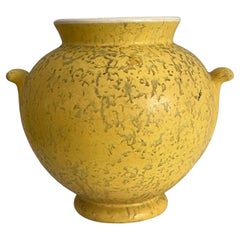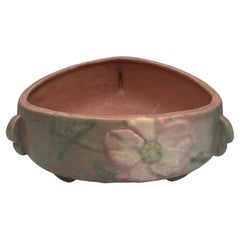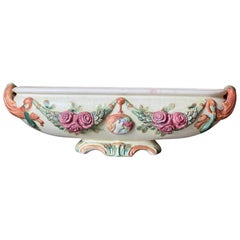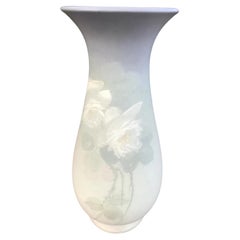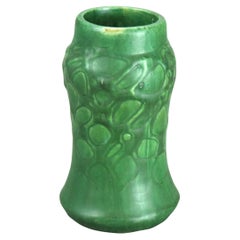Weller Antique
to
13,252
51,696
50,185
54,381
36,238
36,238
19,349
16,334
10,050
9,544
7,553
6,930
5,311
3,690
3,295
3,268
3,094
2,509
2,361
2,157
1,825
1,221
1,178
1,127
1,118
1,005
1,003
679
637
605
507
475
440
427
409
376
311
256
248
151
142
92
87
80
75
73
73
60
60
42
40
31
20
3
2
1
1
225
221
182
170
167
Sort By
Ceramic Vase by Weller Pottery
By Weller Pottery
Located in St.Petersburg, FL
A charming ceramic pot by Weller, signed on the bottom, with handles. Beautiful decoration and
Category
1920s American Art Deco Weller Antique
Materials
Ceramic
Weller Wild Rose Three-Sided Jardiniere Planter
By Weller Pottery
Located in Red Lion, PA
Weller Wild Rose Three-Sided Jardiniere Planter
This beautiful Weller Wild Rose three-sided
Category
1920s Arts and Crafts Weller Antique
Materials
Ceramic
Weller Pottery Roma Rose Planter or Compote
By Weller Pottery
Located in Redding, CT
In 1872, Samuel A. Weller founded Weller Pottery in Fultonham, Ohio, United States. Originally, his
Category
1920s American Art Nouveau Weller Antique
Materials
Ceramic, Clay
Weller Pottery Roma Rose Planter or Compote
By Weller Pottery
Located in Redding, CT
In 1872, Samuel A. Weller founded Weller Pottery in Fultonham, Ohio, United States. Originally, his
Category
1920s North American Art Nouveau Weller Antique
Materials
Ceramic, Clay
pair of Weller Roma Rose Compotes or Planters
By Weller Pottery
Located in Redding, CT
Pair of Weller Roma Rose Compotes or Planters. Very Rare find, especially a pair.
Lovely romantic
Category
1920s American Art Nouveau Weller Antique
Materials
Clay, Ceramic
Weller Louwelsa Standard Glaze Ceramic Vase, Elegant Shape
By Weller Pottery
Located in Phoenix, AZ
Weller Louwelsa standard glaze ceramic vase in mint condition.
Marked: Weller and Louwelsa
Category
Early 20th Century Arts and Crafts Weller Antique
Materials
Ceramic
Antique Weller Roma Jardinière and Pedestal c 1910s
By Weller Pottery
Located in Toledo, OH
Antique Weller jardinière and pedestal pottery, three pieces, Roma style fruit and leaf border
Category
1910s North American Arts and Crafts Weller Antique
Materials
Pottery
SUPERB Large Weller Hudson Vase - Art Pottery - Stickley Era
By Weller Pottery
Located in Shamokin Dam, PA
SUPERB large Weller Hudson Vase - Stickley Period. This large sized vase is in pristine condition
Category
Early 20th Century American Arts and Crafts Weller Antique
Materials
Glass
Antique Weller Arts & Crafts Embossed Matt Green Pottery Vase C1910
By Weller Pottery
Located in Big Flats, NY
Antique Weller Arts & Crafts Embossed Matt Green Pottery Vase C1910
Measures- 5.75"H x 3.25"W x
Category
Early 20th Century Arts and Crafts Weller Antique
Materials
Pottery
$300 Sale Price
20% Off
H 5.75 in W 3.25 in D 3.25 in
American antique ceramic glass ornamental aquarium Weller Loranger, early 1900s
By Weller Pottery
Located in MIlano, IT
American antique ceramic glass ornamental aquarium Weller Loranger, early 1900s
Ornamental ceramic
Category
Early 1900s Italian Weller Antique
Materials
Ceramic, Glass
$481
H 13.98 in W 11.03 in D 6.7 in
Antique Arts & Crafts Hand-Painted Art Pottery Vase by Weller Pottery
By Weller Pottery
Located in Van Nuys, CA
Antique Arts & Crafts art pottery vase by Weller Pottery features pink and white floral design on
Category
1920s American Art Deco Weller Antique
Materials
Pottery
Art Nouveau Hand-Painted Art Pottery Vase by Weller Pottery
By Edward Weller
Located in Van Nuys, CA
Antique Arts & Crafts art pottery Hudson Perfector vase by Weller Pottery features a pink and white
Category
1910s American Weller Antique
Materials
Pottery
$3,600 Sale Price
47% Off
H 16 in W 7 in D 7 in
Antique Weller Art & Crafts Floral Embossed Matt Green Pottery Bowl C1910
By Weller Pottery
Located in Big Flats, NY
Antique Weller Art & Crafts Floral Embossed Matt Green Pottery Bowl C1910
Measures- 3.5"H x 8.75"W
Category
Early 20th Century Arts and Crafts Weller Antique
Materials
Pottery
$440 Sale Price
20% Off
H 3.5 in W 8.75 in D 8.75 in
Pair of Large Weller Pottery Matte Green Leaf Jardinières Circa 1910
By Weller Pottery
Located in Miami, FL
Pair of Large Weller Pottery Matte Green Leaf Jardinières Circa 1910
Offered for sale is a pair
Category
1910s American Weller Antique
Materials
Pottery
$1,760 Sale Price / set
20% Off
H 10 in Dm 11.5 in
Large Antique Weller Sicard Irridescent Art Pottery Vase with Stylized Flowers
By Weller Pottery
Located in Hamilton, Ontario
This vase was made by the renowned Weller Pottery factory of the United States in approximately
Category
Early 20th Century American Art Nouveau Weller Antique
Materials
Pottery
John Sanderson Wells , oil, horses, horse riding country scene
By John Sanderson-Wells
Located in York, GB
A fine oil painting by the renowned artist John Sanderson Wells
" Returning from a Country Ride
Category
Early 20th Century Old Masters Weller Antique
Materials
Oil
$5,598
H 23.63 in W 30.71 in D 3.55 in
19th Century Portrait, Child At Play , Attributed To Henry Tanworth Wells
Located in York, GB
19th century portrait, child at play ,Attributed to Henry Tanworth Wells
A beautiful oval portrait
Category
19th Century Old Masters Weller Antique
Materials
Oil
$8,758
H 31.11 in Dm 24.41 in
Goose, Girl 19th Century by William Page Atkinson WELLS (1872-1923)
By William Page Atkinson Wells
Located in Blackwater, GB
Goose, Girl 19th Century
by William Page Atkinson WELLS (1872-1923)
19th Century view of farm
Category
19th Century Weller Antique
Materials
Canvas, Oil
$9,809
H 15.5 in Dm 21 in
C R Mackintosh Guthrie & Wells, Glasgow School Stained Green Cypress Wardrobe
By Charles Rennie Mackintosh, Guthrie and Wells
Located in London, GB
Charles Rennie Mackintosh (1868-1928), made by Guthrie and Wells.
A Glasgow School Arts and Crafts
Category
Late 19th Century Scottish Arts and Crafts Weller Antique
Materials
Brass
$30,828
H 75.01 in W 57.88 in D 20.48 in
Northern Italian Well
Located in Dallas, TX
This unique 16th-century Northern Italian well features an impressive limestone base and an iron
Category
15th Century and Earlier Weller Antique
Materials
Limestone, Iron
At Tunbridge Well
By Agostino Aglio
Located in Middletown, NY
invitation of well known British architect William Wilkins (designer of the National Gallery and University
Category
Early 19th Century Old Masters Weller Antique
Materials
Crayon, Handmade Paper, Laid Paper, Color Pencil, Graphite
Marble Ink Well
Located in South Salem, NY
A pair of Italian marble ink wells with covered well and brass handle. Beautiful contrasting black
Category
19th Century Italian Weller Antique
Materials
Marble
Rebecca at the Well
Located in Fredericksburg, VA
Nicola Maria Rossi masterfully captures the biblical tale of Rebecca and Eliezer at the Well, a
Category
18th Century Old Masters Weller Antique
Materials
Canvas, Oil
Sketch of the Well
By Frank Anderson
Located in Fredericksburg, VA
Frank Anderson's "Sketch of the Well" is a delicate and evocative drawing rendered in graphite on
Category
Mid-19th Century Hudson River School Weller Antique
Materials
Paper, Graphite
William Shakespeare's "All's Well That Ends Well"after Wheatley- Etching - 1850s
Located in Roma, IT
William Shakespeare's "All's Well That Ends Well" after Wheatley is an etching realized in the
Category
1850s Modern Weller Antique
Materials
Etching
$216 Sale Price
25% Off
H 8.67 in W 6.7 in D 0.04 in
17th Century Limestone Well
Located in Dallas, TX
Beautiful well dating back to the 1600s. Item originates from France.
Category
17th Century French Weller Antique
Materials
Limestone
Antique Cotswold Limestone Well
Located in Wormelow, Herefordshire
A late 18th century English limestone well head removed from a property in Gloucestershire
Category
Mid-18th Century Weller Antique
Materials
Limestone
17th Century Limestone Well
Located in Beervelde, BE
This is a particular original small well. Perfect for a French garden. It is in a perfect condition
Category
18th Century French Louis XIV Weller Antique
Materials
Limestone
The Well of Merlin
Located in Boston, MA
Signed and dated lower center: "Bryson Burroughs 1921". In fine condition.
Exhibited: 1924 Art Institute of Chicago Annual Exhibition.
Published: Illustrated in Catalogue of 1924 Ar...
Category
Early 20th Century Symbolist Weller Antique
Materials
Oil
19th Century Japanese Satsuma Porcelain Water Well Bucket, Wishing Well Vase
By Satsuma
Located in Vero Beach, FL
This Japanese porcelain vase is barrel shaped with a yolk handle. It is both finely and intricately hand painted. It pictures groups of scholars with scrolls dressed in elaborate bro...
Category
Late 19th Century Japanese Meiji Weller Antique
Materials
Porcelain
$600 Sale Price
20% Off
H 5 in W 4.13 in D 4.13 in
Italian Antique Octagonal Marble Well
Located in Encinitas, CA
This piece is an Italian Antique Octagonal Marble Well imported directly from Veneto, Italy that
Category
18th Century Italian Romantic Weller Antique
Materials
Marble
Vintage Toy, Wind up Locomotive Wells-Brimtoy 7040, by Wells-Brimtoy, 1930s
Located in Roma, IT
This Wind up Locomotive Wells-Brimtoy 7040 is an originale mechanical toy.
Vintage wind up toy
Category
Early 20th Century English Weller Antique
Materials
Metal
$248 Sale Price
25% Off
H 3.55 in W 6.7 in D 2.56 in
Asian Well's Wooden Water Bucket
Located in Greenwich, CT
Asian well's water wooden water bucket with handle surrounded with cast iron brackets. We carry
Category
1920s Chinese Ming Weller Antique
Materials
Wood
18th Century Burgundy Limestone Well
Located in Dallas, TX
This well origins from Burgundy region in France, circa 1780.
Made with limestone and wrought
Category
18th Century French Weller Antique
Materials
Limestone
Chinese Well Bucket, c. 1900
Located in Chicago, IL
This vintage water bucket conjures up images of water-bearing figures illustrated in painted scrolls. Beautifully aged with a warm patina, this Qing-dynasty bucket draws attention to...
Category
Early 20th Century Chinese Rustic Weller Antique
Materials
Iron
Tunbridge Wells Ruler, 19th Century
Located in Spencertown, NY
The ruler with differing scales on each side.
Category
19th Century English Victorian Weller Antique
Materials
Wood
Fare Thee Well! Liberty Magazine Cover
By Leslie Thrasher
Located in Fort Washington, PA
Original cover for Liberty magazine, published August 4, 1928.
Having left her husband Sandy, Lil returns to the Morse family home with her two-month-old baby. Ma Morse worries abou...
Category
1920s Weller Antique
Materials
Canvas, Oil
Portrait of Chlorinda with Letter - British art Victorian genre oil painting
By George Wells
Located in London, GB
This charming oil portrait painting is by noted British Victorian artist George Wells. Painted
Category
19th Century Realist Weller Antique
Materials
Oil
George WellsPortrait of Chlorinda with Letter - British art Victorian genre oil painting, Circa 1880
$3,335 Sale Price
20% Off
H 30 in W 23 in D 2 in
C1680 Oak Bible Box Well Carved
Located in Bakewell, GB
C1680 oak bible box well carved on 3 sides
good colour and patination
58cms Wide x 45cms Deep x
Category
1680s Weller Antique
Materials
Oak
Well figured mahogany two door wardrobe
Located in Cheshire, GB
Mahogany wardrobe, the carved moulded cornice above two well figured mahogany panelled doors
Category
Early 20th Century British Weller Antique
Materials
Wood
Well Weathered Ships Copper Navigation Light.
Located in Godshill, Isle of Wight
Well Weathered Ships Copper Navigation Light.
The lamp is flat sided with original bowed and
Category
Early 1900s Industrial Weller Antique
Materials
Copper
Antique Stone Well Top, GE-1626
Located in Scottsdale, AZ
Antique stone well top.
Item #: GE-1626
Material: Stone
Dimensions: 41.25”D x 51.25”W x 8”H.
Category
19th Century European Weller Antique
Materials
Stone
New Map of the Terraqueous Globe - WORLD MAP - CALIFORNIA AS AN ISLAND
By Edward Wells
Located in Santa Monica, CA
EDWARD WELLS (British 1667- 1727)
A NEW MAP of the TERRAQUEOUS GLOBE - according to the latest
Category
Early 1700s Old Masters Weller Antique
Materials
Engraving
$1,750
H 14.25 in W 20.125 in
Italian Empire Bronze Sienna Marble Ink Well
Located in Scottsdale, AZ
Italian Empire Bronze Sienna Marble Ink Well. Unique piece purchased in France. Age appropriate
Category
Early 19th Century French Empire Weller Antique
Materials
Siena Marble, Bronze
Antique Bluestone Well Cover, 19th Century
Located in Udenhout, NL
This well cover can be used to put on a well. The well cover is in a nice shape and in a good
Category
1860s Belgian Weller Antique
Materials
Stone
Antique Bluestone Well Cover 19th Century
Located in Udenhout, NL
This well cover can be used to put on a well. The well cover is in a nice shape and in a good
Category
1840s Belgian Weller Antique
Materials
Stone
Regency Well-Figured Mahogany Writing Table
Located in Lymington, Hampshire
A Regency well-figured mahogany writing table, of rectangular form with a green leather-inset top
Category
1810s Great Britain (UK) Weller Antique
Materials
Mahogany
19th Century Italian Marble Well Head
Located in Los Angeles, CA
Very rare 19th c. Italian Marble Well Head signed by Professor Polizi, Firenze, Italy
Category
19th Century Italian Weller Antique
Materials
Marble
19th Century Embroidery - Rebecca at the Well
Located in Corsham, GB
A charming embroidery depicting the biblical story from Genesis 24:11–22 'Rebecca and the Well
Category
19th Century Weller Antique
Materials
Tapestry
Well Proportioned Polished Wrought Iron Firebasket
Located in London, GB
A 19th century English polished wrought iron firegrate of gothic influence. The shaped front bars with uprights featuring scrolled feet and tops. Shaped cast iron back.
Width At Fro...
Category
19th Century English Weller Antique
Materials
Iron
1910 Vintage Art Pottery Floral Ceramic Umbrella Holder
By Weller Pottery
Located in Redding, CT
1910 Vintage Art Pottery Floral Ceramic Umbrella Holder. Gorgeous deep greens and golds.
Category
Early 1900s Art Nouveau Weller Antique
Materials
Ceramic
Well Proportioned Early 19Th C. Portuguese Coffer
Located in London, GB
A well proportioned northern Portuguese chestnut coffer from the early 19th C.
Heavily patinated
Category
Early 19th Century Portuguese Weller Antique
Materials
Chestnut
"Hecate, " Second Cross from the Bulldog
Located in Columbia, MO
"Hecate, " Second Cross from the Bulldog
1887
Etching
3 x 5
Category
Late 19th Century Naturalistic Weller Antique
Materials
Etching
"Lady, " an English Terrier
Located in Columbia, MO
"Lady, " an English Terrier
1887
Etching
3 x 5
Category
Late 19th Century Naturalistic Weller Antique
Materials
Etching
"Hermit, " a High-Bred Modern Foxhound
Located in Columbia, MO
"Hermit, " a High-Bred Modern Foxhound
1887
Etching
3 x 5
Category
Late 19th Century Naturalistic Weller Antique
Materials
Etching
The Spanish Pointer
Located in Columbia, MO
The Spanish Pointer
1887
Etching
3 x 5
Category
Late 19th Century Naturalistic Weller Antique
Materials
Etching
The Boarhound
Located in Columbia, MO
The Boarhound
1887
Etching
3 x 5
Category
Late 19th Century Naturalistic Weller Antique
Materials
Etching
Dog and Fox Cross
Located in Columbia, MO
Dog and Fox Cross
1887
Etching
3 x 5
Category
Late 19th Century Naturalistic Weller Antique
Materials
Etching
- 1
- ...
Get Updated with New Arrivals
Save "Weller Antique", and we’ll notify you when there are new listings in this category.
Weller Antique For Sale on 1stDibs
Choose from an assortment of styles, material and more with respect to the weller antique you’re looking for at 1stDibs. A weller antique — often made from wood, metal and ceramic — can elevate any home. There are many kinds of the weller antique you’re looking for, from those produced as long ago as the 18th Century to those made as recently as the 20th Century. When you’re browsing for the right weller antique, those designed in Victorian, Georgian and Art Nouveau styles are of considerable interest. Weller Pottery, Minton and Jerome Massier each produced at least one beautiful weller antique that is worth considering.
How Much is a Weller Antique?
The average selling price for a weller antique at 1stDibs is $2,725, while they’re typically $18 on the low end and $225,000 for the highest priced.
